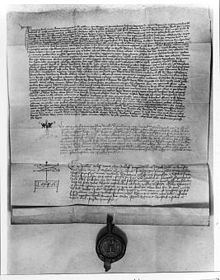- Decree of Kutná Hora
-
The Decree of Kutná Hora (Czech: Dekret Kutnohorský) or Decree of Kuttenberg (German: Kuttenberger Dekret) was issued in Kutná Hora, Bohemia, by King Wenceslas IV to give members of the Bohemian university nation a decisive voice in the affairs of the Charles University in Prague.
The doctrines of John Wycliffe led to controversy at the University of Prague in 1403. Jan Hus wanted to teach this new doctrine, but most German masters and professors rejected the new thinking. Jerome of Prague went to Wenceslas, who promised to change the constitution of the university.
The three foreign nations (Poland, Bavaria and Saxony) at the university opposed the request of Wenceslas to take a neutral attitude between the two rival popes in the Great Schism. On 18 January 1409, Wenceslas changed the statutes of the university. With this decree he gave the Bohemian nation three votes and one vote to the other three nations. Shortly after that, Hus himself became rector of the university.
As another result of the Decree of Kutná Hora, somewhere between 5,000 and 20,000 German doctors, masters, and students left the university. This exodus resulted in the foundation of the University of Leipzig, among others. The rising influence of this doctrine and the execution of Hus was the beginning of the Hussite Wars.
External links
Categories:- 1409 in Europe
- History of Prague
- University of Leipzig
- Charles University in Prague
- Czech building and structure stubs
- Europe university stubs
- German history stubs
Wikimedia Foundation. 2010.


